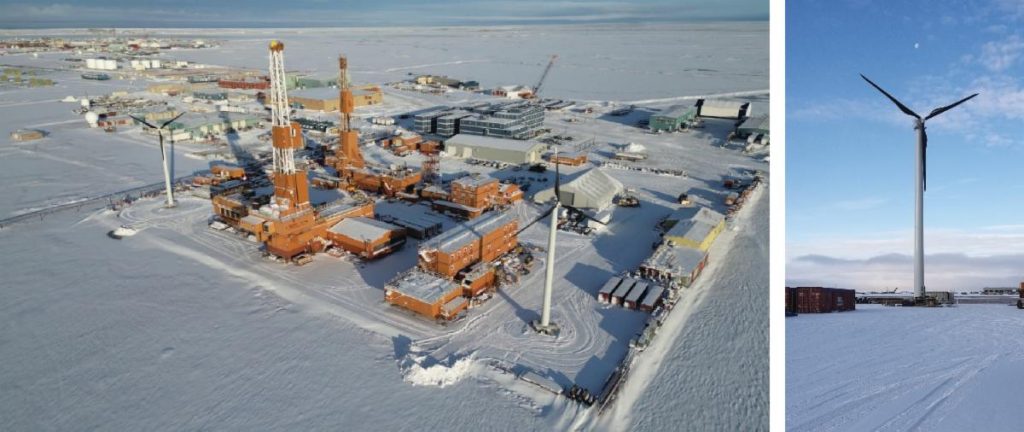
In late 2023, two NPS100C-24 Arctic turbines on 29-meter-tall towers were installed at the Doyon Drilling site in Alaska. Courtesy of Northern Power Systems (NPS).
DWEA member Northern Power Systems (NPS), established in 1974 in Vermont, has specialized in the development of wind turbines and related technologies for both on-grid and off grid applications for the past 50 years. The NPS100C wind turbine products offer on-site power generation and help reduce energy costs for agriculture (ranching, dairy, farming, rural small businesses), industrial sites, educational institutions (universities, colleges, technical schools), businesses, hospitals, and remote locations seeking alternatives to traditional fuel sources (such as islands and native villages). Since 2009, NPS has established itself as a leader in the small-medium wind turbine industry with more than 870 units installed on five continents. The NPS turbine is well known to endure the harshest environmental conditions in Alaska and the lower 48 of the U.S. The NPS 100C platform is proven technology for hurricane prone Caribbean Islands to the windy Scottish Highlands. NPS is excited to be fully operational again in the U.S. with business development led by Ken Kotalik and the Engineering team headed by Chris Connor. The improved NPS100C platform supports four rotor diameters from 21 to 28 meters and is suited for most wind resources. Tower heights vary between 30 to 37 meters, depending on the site and wind resource. In the U.S., NPS recently completed the installation of an NPS100C-27 (27-meter rotor) turbine on a 37-meter-tall tower for Kentucky Utilities in Harrodsburg, Kentucky, which is connected to the utility’s research microgrid with a 10 MW solar system and large lithium-ion battery storage system. This turbine is believed to be the first “commercial scale” wind turbine in Kentucky. In late 2023, two NPS100C-24 Arctic turbines on a 29-meter tower were installed at the Doyon Drilling site in Alaska. The site is on the North Slope and among the northernmost wind turbines in the world at 70.2 degrees latitude. Needless to say, it’s a harsh and challenging environment, but the NPS platform is performing well. The Arctic version of the NPS100C is designed to operate in -40 degrees Celsius with low-temperature steels, hydrophobic/ice-phobic blade coating, ice detection system, and nacelle heating system. NPS provides comprehensive service options based on customer requirements, offering options ranging from full or partial installation, scheduled or unscheduled maintenance and extended warranty programs and turnkey solutions. To learn more, please visit the new NPS website or contact Ken Kotalik at kkotalik@nps100.com.
Windurance Develops UL 1741 Certified Integrated Storage Control

Windurance is implementing its bidirectional DC power converter technology to connect batteries directly into the DWER’s DC power bus and including them in the Windurance “Power Data Network” used to control the full DWER electric power conversion system. Courtesy of Windurance.
DWEA member Windurance received a 2022 U.S. Department of Energy Competitiveness Improvement Project (CIP) award to develop energy storage control products certified according to UL 1741 and integrated with their portfolio of Distributed Wind Energy Resource (DWER) power conversion products. According to National Renewable Energy Laboratory (NREL), combining battery energy storage with distributed wind energy systems can increase production, ability to meet local electricity demands, interconnection capacity, and potential sales of energy back to the grid, while reducing the overall levelized cost of energy (LCOE). Energy storage options for distributed wind energy systems can vary widely in terms of power level and energy storage capacity. With a shared investment from the NREL CIP, Windurance is implementing its bidirectional DC power converter technology to connect batteries directly into the DWER’s DC power bus and including them in the Windurance “Power Data Network” used to control the full DWER electric power conversion system. The storage controls are battery technology agnostic in that the charge/discharge characteristics are managed by the storage controller as a network peripheral device. For example, battery technologies include deep cycle lead acid, Nickel-Iron, Lithium-Iron-Phosphate (LFP) and Lithium-Nickel-Cobalt-Aluminum Oxide (Li-NCA) will be supported to accommodate a wide range of cost v. performance targets according to the application needs and evolving storage technologies. Battery connections are an end user safe voltage to service and maintain at 48Vdc. Power levels arescalable in 10 kW blocks up to the full rating of the DWER power Converter and Inverter. Energy storage capacity is scaled by the number of batteries on each independent 48V block. Certification is according to UL 1741 Standards for Safety Inverters, Converters, and Interconnection System Equipment for Use with Distributed Energy Resources. Windurance anticipates having units available for field trials in the second quarter of 2025.
